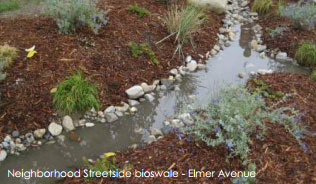Install Rain Gardens or Bioswales
Information and resources on installing a rain garden or bioswales.
Description

A rain garden is a planted depression or a hole that collects rainwater runoff from impervious urban areas, like roofs, driveways, walkways, parking lots, and compacted lawn areas;and then allows it to be absorbed back into the ground. A bioswale is similar, but it is specifically meant to clean water and slow run-off as it is directed to flow from one point to another - perhaps from a parking lot to a rain garden. Both are designed with native plants that clean water, slow it down, and encourage absorption to relieve pressure on our gray water systems, sewers, streams, and rivers.
Related Tools
When paired with other tools, rain gardens and bioswales can contribute to a greater and more holistic sustainable neighborhood. Think about neighborhood greening, streetscape, safety, biodiversity and habitat, and community gardens. Try combining rain gardens and bioswales with:
Community Projects
Add your project
Neighborhood Benefits
Environmental
- Reduced impact on sewers, streams, and rivers
- Decreased water pollution and increased ground water infiltration Greening, biodiversity, native plants, and habitat for less maintenance and a more beautiful neighborhood
- Support for urban animal habitat
- Reduced risk of soil erosion
Social
- More beautiful, comfortable, and safer streets and blocks
- Reduced risk of flooding
- Improved access to natural landscapes and urban habitats
- Opportunities for learning
Economic
- Reduced maintenance on gray water systems
- Reduced risk of combined sewer overflow and associated costs
- Improved neighborhood appearance and value
Get Started
- Organize Talk to interested neighbors or neighborhood organizations about creating bioswales and/or rain gardens in your neighborhood. Work closely with your neighborhood association and alderman to discuss feasible ideas and any work that has previously been done.
- Find a Site Brainstorm possible locations for rain gardens or bioswales to see which property owners may be interested or which streets, intersections, or sites would be most appropriate. If planning to work in the public right of way, your project must be coordinated with Metropolitan Sewer District (MSD), St. Louis Board of Public Service, and possibly the Streets Department. Understand the design requirements for your rain garden or bioswale and work within those guidelines to achieve the best project for your community.
- Design Design your rain garden or bioswale using best practice standards. How-to guides and plant and design recommendations are available through MSD, Missouri Botanical Garden, HOK, Rain Garden Network, and WikiHow. You may need to work with approved contractors if there are modifications to curbs, crosswalks, medians, or streets involved.
- Cost and Fund Price your project to understand installation costs. If more funding is needed, research various city resources and organizations similar to the University City Rebate Program, such as Wild Ones, Gateway Greening, Missouri Botanical Garden.
- Permit Once your proposed design is complete, get the proper permissions and permits necessary for construction, and get the design approved by your neighborhood association and community. Coordinate with Metropolitan Sewer District (MSD), St. Louis Board of Public Service, and possibly the Streets Department.
- Install Host an installation workday with volunteers from your community to help construct the rain garden. Order materials to ensure that plants, tools, and other construction materials arrive on time. Everyone should have a role and be contributing safely to the project. If two workdays are necessary, plan so there are enough volunteers for 2 days.
- Maintain A condition of the permit approval will involve developing a plan for maintenance of the rain garden. Identify the type of maintenance activities, such as trash removal, weeding, replacing dead vegetation, trimming, mulching, etc. Determine who will maintain the garden and how often.
Opportunities
Related Categories
Sustainability Plan Categories
Project Scale
- Block
- Neighborhood
- Private Site
- Public Building
- Street
Download This Tool
Install Rain Gardens or Bioswales Doc (419.45 KB pdf)
Need Help Viewing?
You need a program that can open Adobe PDF files. A free option:
- Adobe Reader can read PDF files